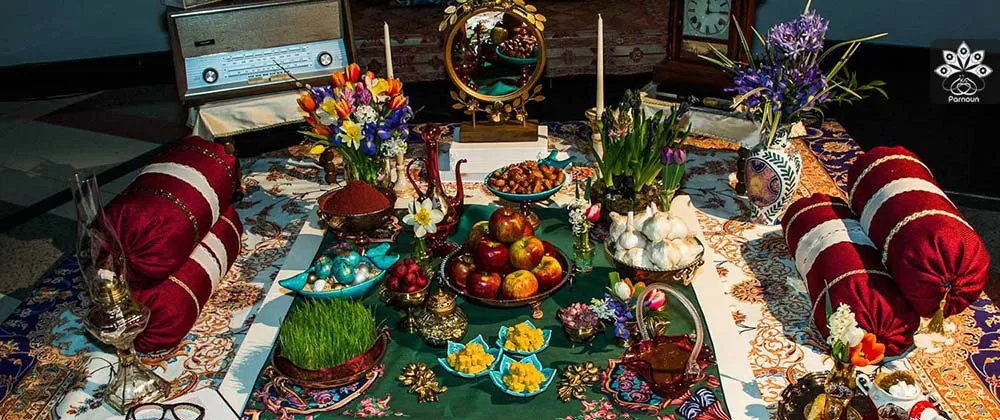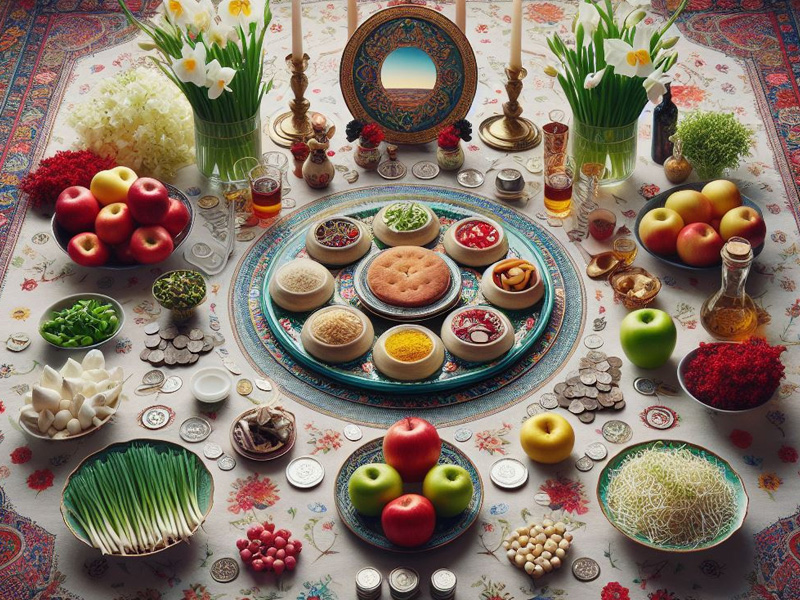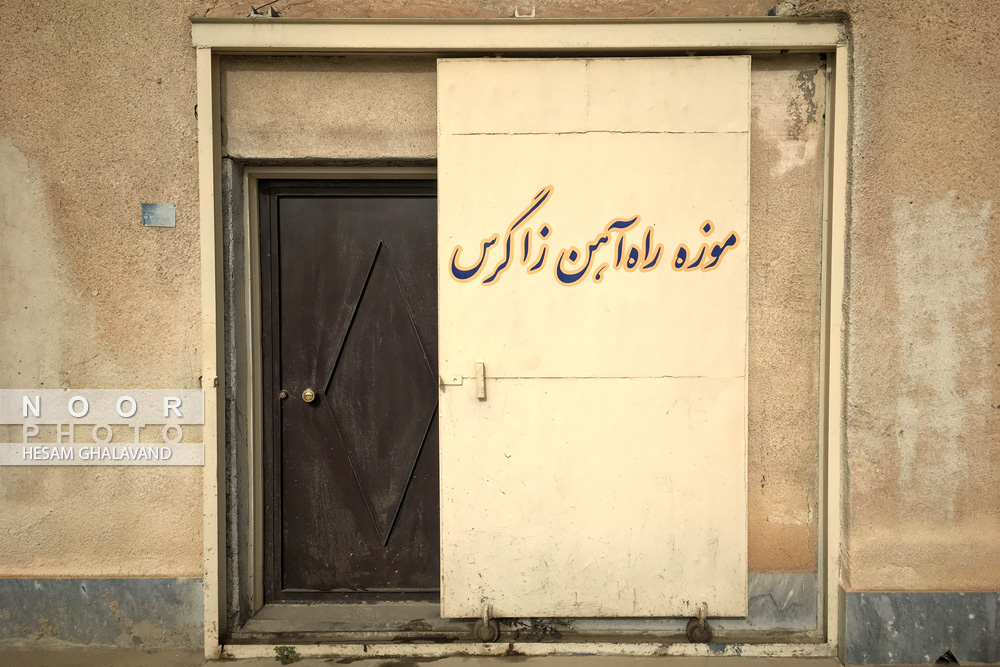sofreh haft sin | The History of Haft Sin and Secrets You Didn’t Know
The Haft Seen spread is one of the most essential traditions of the Nowruz celebration. As the New Year approaches, Iranians and people in some other countries influenced by Iranian culture arrange a spread consisting of seven symbolic items, sitting around it at the turn of the year. Although the practice of spreading this spread dates back to ancient times, its form has been different from today’s spreads, and the existence of seven specific items in this spread was not mandatory. Stay tuned with Eli Ghasht to provide you with more information about the history of the Haft Seen spread and its secrets and mysteries.
Philosophy of Haft Seen
The roots of the philosophy of Haft Seen should be sought in the beliefs of ancient Iranians. Ancient Iranians believed that during the days of Nowruz, the spirits of the deceased return to the earth and to their homes, and for this reason, they spread spreads and placed various foods and clothing inside them to welcome them. Some researchers also believe that ancient Iranians spread spreads in the new year to honor earthly blessings. In the past, there was no necessity to use elements with the letter “S” in this spread.
In ancient times, this spread was spread on a surface higher than the ground level, which was called “Miz,” and various seasonal products, worship tools, candles, wine, and sweets were placed in it. After being blessed, the seasonal products and food items of the spread were distributed among the participants by a designated person (called “Mizdapan,” meaning the distributor of sacrificial food). Today, the word “Miz” in Persian has remained from “Mizd” and “Mizban” from the word “Mizdapan”.
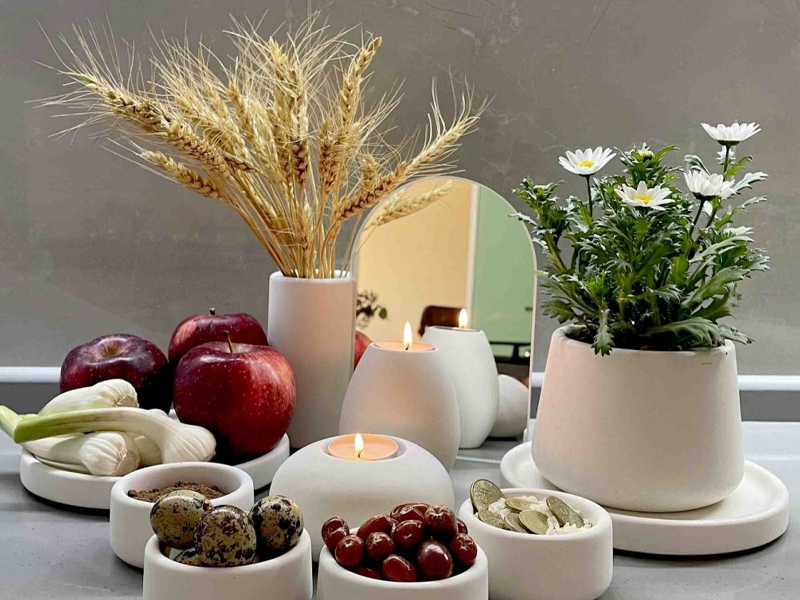
Symbols of Haft Seen in ancient times
According to some accounts, during the Sassanian period, beautiful and decorated vessels and containers made of porcelain were brought from China to Iran and became famous as “Sini” or “Chini.” The term “Chini” or “Sini” is derived from the word “ts’in,” the name of the Chinese dynasty. Seven of these vessels were arranged as symbols of the seven holy Ameshaspands and placed on Nowruz spreads, and it is believed that “Haft Seen” or “Haft Sini” refers to this subject. Later, the letter “ی” (which means “of” in Persian) was removed from “Haft Sini,” and only “Haft Seen” remained. Today, in some villages, the Nowruz spread is still called “Haft Sini.”
Iranian nowruz traditions | From the customs before Nowruz until the 13th
Why Seven?
In general, the number seven was considered sacred among ancient Iranians, and the seven holy Ameshaspands included Ahura Mazda (meaning Lord of Wisdom), Spenta Armaiti (love and devotion), Ameretat (guardian of plants), Khordad (joy and perfection), Bahman or Homan (good thought), Ardibehesht (purity and truth), and Shahrevar (desired rulership with eternal kingdom).
Furthermore, according to some historical sources, ancient Iranians had a spread called “Haft Shin” which over time transformed into “Haft Seen.” The components of this spread included wine, candles, honey, sweets, sherbet, wild rue, and poppy petals or branches of vegetation.
History of Haft Seen
Although the exact history of Haft Seen is not clear, the oldest reference to this term dates back to the years 757 to 835 AH in the Diwan of Amir Bahauddin Khojandi. Abu Rayhan Biruni in the book “Al-Mahasen wal-Azdad” attributed to Jahiz and “Aasar al-Baqiyah” refers to the greening of seven types of grains during Nowruz.
In another text written by Ibrahim Sultan Timuri (796 to 838 AH), about Nowruz and Haft Seen, it is said: “On the day of Nowruz, a group said that according to astrological views, this year, activities should be done related to things that begin with the letter ‘S’, such as eating lettuce and vinegar, wearing sashes and socks, and Mawlana Nur said, ‘Then we should also wear wool.'”
Tashkubrizadeh (died in 968 AH), an Ottoman historian, mentions the Haft Seen of Nowruz in his book “Miftah al-Saadah wal-Musbah al-Siyadah,” stating that Iranians arrange a spread and place seven symbolic items in it, which they then consume during Nowruz.
During the Qajar period, Sultan Ahmad Mirza Azod al-Dawlah refers to the custom of Haft Seen in the court of Fath Ali Shah (on the thirteenth day of Nowruz). Additionally, a page from the newspaper “Ettela’at al-Saltanah,” which belongs to the time of Naser al-Din Shah, mentions Haft Seen and a red fish on the Haft Seen spread. Other references to Haft Seen include the travelogues of Wilson and Henri Rene, as well as two written pages from the book “Iran” by Fakhr al-Din Shokat, an Ottoman diplomat.
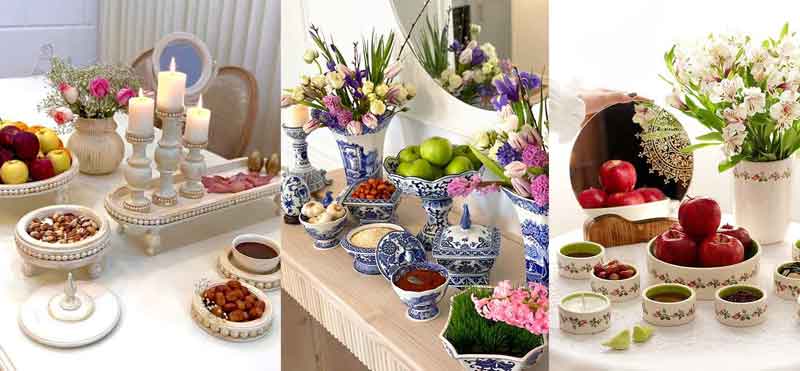
Components of Haft Seen
The main components of Haft Seen include Sabzeh (wheat, barley, or lentil sprouts), Seer (garlic), Sib (apple), Samanu (wheat germ pudding), Senjed (dried oleaster fruit), Serkeh (vinegar), Sumac (crushed sour berries), and Sekkeh (coins). Each of these components symbolizes something:
- Sabzeh: symbolizes growth, progress, and purity.
- Seer: symbolizes the struggle between good and evil.
- Sib: symbolizes fertility and nurturing.
- Samanu: symbolizes blessing and abundance.
- Senjed: symbolizes affection and attachment.
- Serkeh: symbolizes patience and longevity.
- Sumac: symbolizes the arrival of rain.
- Sekkeh: symbolizes prosperity and livelihood.
Other Items on the Haft Seen Spread
In addition to the seven main components of the Haft Seen spread, other items such as a mirror, poetry books, religious texts, candles and candlesticks, hyacinth flowers, colored eggs, rosewater, a bowl of water containing oranges or a fish, nuts, and sweets are also placed on this spread, each carrying a specific meaning and concept. For example, candles symbolize enlightenment and overcoming darkness, colored eggs symbolize lineage and fertility, and mirrors symbolize purity and transparency.
Regarding the presence of a red fish on the Haft Seen spread, there is no consensus. The red fish is a symbol of the Chinese New Year, and some suggest that it might have been included in the Iranian Haft Seen spread less than a century ago. However, existing evidence such as the golden fish statuette from the Achaemenid period and the silver statuette in the style of the Elamite civilization from 600 to 900 BCE indicates that Iranians have been familiar with the red fish for at least 2500 years. Additionally, in the past, this fish could be found in Lake Urmia, the ponds of the Caspian Sea, Lake Hamun, and the Karun River.

Summary of the History of Haft Seen and its Secrets
In this article, we provided explanations about the philosophy and history of the Haft Seen spread. We also introduced the components of this spread and their symbols. As mentioned, the tradition of arranging the Haft Seen spread is an ancient Iranian custom that has undergone changes over time. Today, this spread is widely displayed in Iranian homes from the first day of Nowruz to the thirteenth day, and during the New Year celebrations, all family members gather around it, praying for a good year from God.
pictures of sofreh haft sin




